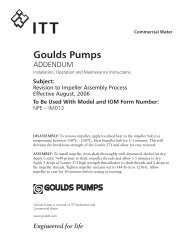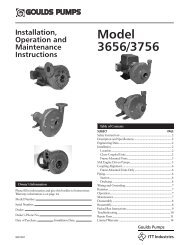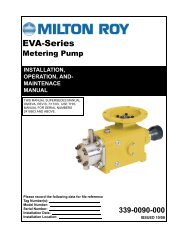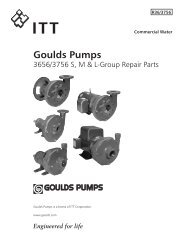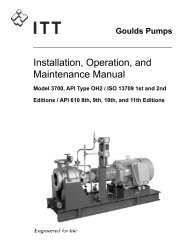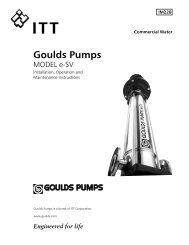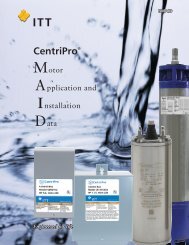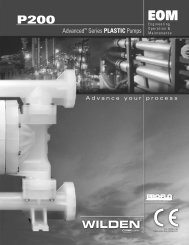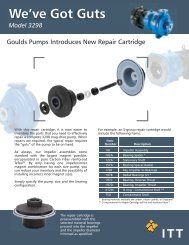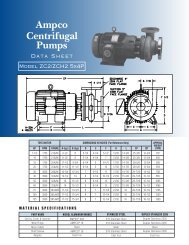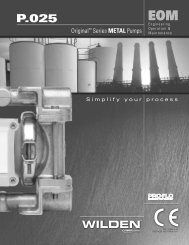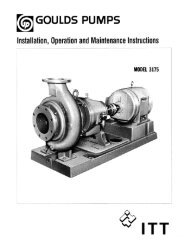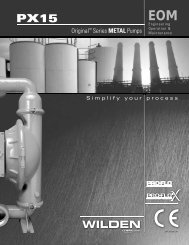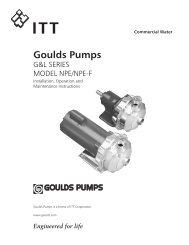Goulds Pumps
Goulds Pumps
Goulds Pumps
You also want an ePaper? Increase the reach of your titles
YUMPU automatically turns print PDFs into web optimized ePapers that Google loves.
11. Troubleshooting<br />
1. Motor does not start, and no noise or vibration occurs:<br />
1.1. Power supply not connected.<br />
1.2. Fuses or protection device tripped or defective.<br />
1.3. Loose or broken electrical connections.<br />
2. Motor will not start, but generates noise and vibration:<br />
2.1. Motor not wired as directed on diagram.<br />
2.2. Shaft locked due to mechanical obstructions in<br />
motor or pump.<br />
2.3. Low voltage or phase loss on three phase supply.<br />
3. Pump does not deliver rated capacity:<br />
3.1. Pump not filled and primed.<br />
3.2. Pump has lost prime due to leaks in suction line.<br />
3.3. Direction of rotation incorrect. See Rotation.<br />
3.4. Head required is higher than that originally<br />
specified. (Valve may be partially closed.)<br />
3.5. Foot valve clogged.<br />
3.6. Suction lift too high.<br />
3.7. Suction pipe diameter too small.<br />
4. Protection trips as unit starts:<br />
4.1. Phase loss on three-phase supply.<br />
4.2. Protection device may be defective.<br />
4.3. Loose or broken electrical connections.<br />
4.4. Check motor resistance and insulation to ground.<br />
5. Protection device trips too often:<br />
5.1. Protection may be set to a value lower than motor<br />
full load.<br />
5.2. Phase loss due to faulty contacts or supply cable.<br />
5.3. Liquid is viscous or its specific gravity is too high.<br />
5.4. Rubbing occurs between rotating and stationary<br />
parts.<br />
6. Shaft spins with difficulty:<br />
6.1. Check for obstructions in the motor or the pump.<br />
6.2. Rubbing occurs between rotating and stationary<br />
parts.<br />
6.3. Check bearings for proper conditions.<br />
7. Pump vibrates, runs noisily, and flow rate is uneven:<br />
7.1. Pump runs beyond rated capacity.<br />
7.2. Pump or piping not properly secured.<br />
7.3. Suction lift too high.<br />
7.4. Suction pipe diameter too small.<br />
7.5. Cavitation caused by insufficient liquid supply or<br />
excessive suction losses.<br />
7.6. Impeller blockage.<br />
8. When stopped, unit turns slowly in the reverse direction:<br />
8.1. Leaks on air locks in suction pipe.<br />
8.2. Partial blockage in check valve.<br />
9. In pressure boosting applications, the unit starts and<br />
stops too often:<br />
9.1. Pressure switch settings are incorrect.<br />
9.2. Tank size may be incorrect.<br />
10. In pressure boosting applications, the unit does not<br />
stop:<br />
10.1. Pressure switch maximum setting is higher than<br />
was specified.<br />
10.2. Direction of rotation incorrect. See Rotation.<br />
6



